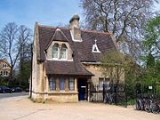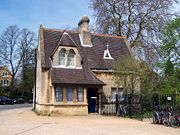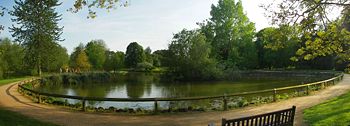
University Parks
Encyclopedia
The Oxford University Parks, more normally the University Parks, or just The Parks to members of the local community, is one large parkland area slightly northeast of the Oxford
city centre in England
. It is open to the public during the day, and has beautiful gardens, large sports fields, and rare and exotic plants.
From 1853 to 1864, the University of Oxford
purchased a total of 91 acres (36.8 ha) of land from Merton College to build the parks. Some of this land was then used for the University Museum
and the Science Area
, so the current site is measured at about 74 acres (29.9 ha). The park is situated mostly on the west bank of the River Cherwell
, though a small plot of land called Mesopotamia
sits between the upper and lower levels of the river. The Parks are bounded by Norham Gardens
to the north, Parks Road
to the west and the Science Area
on South Parks Road
to the south.
Walter Sawyer has been superintendent of the Parks since 1981.

 The following features of the Parks are of special interest:
The following features of the Parks are of special interest:
Oxford
The city of Oxford is the county town of Oxfordshire, England. The city, made prominent by its medieval university, has a population of just under 165,000, with 153,900 living within the district boundary. It lies about 50 miles north-west of London. The rivers Cherwell and Thames run through...
city centre in England
England
England is a country that is part of the United Kingdom. It shares land borders with Scotland to the north and Wales to the west; the Irish Sea is to the north west, the Celtic Sea to the south west, with the North Sea to the east and the English Channel to the south separating it from continental...
. It is open to the public during the day, and has beautiful gardens, large sports fields, and rare and exotic plants.
From 1853 to 1864, the University of Oxford
University of Oxford
The University of Oxford is a university located in Oxford, United Kingdom. It is the second-oldest surviving university in the world and the oldest in the English-speaking world. Although its exact date of foundation is unclear, there is evidence of teaching as far back as 1096...
purchased a total of 91 acres (36.8 ha) of land from Merton College to build the parks. Some of this land was then used for the University Museum
Oxford University Museum of Natural History
The Oxford University Museum of Natural History, sometimes known simply as the Oxford University Museum, is a museum displaying many of the University of Oxford's natural history specimens, located on Parks Road in Oxford, England. It also contains a lecture theatre which is used by the...
and the Science Area
Science Area, Oxford
The Science Area in Oxford, England is where most of the science departments at Oxford University are located.-Overview:The main part of the Science Area is located to the south of the University Parks and to the north of South Parks Road, bounded by Parks Road to the west. Some departments are...
, so the current site is measured at about 74 acres (29.9 ha). The park is situated mostly on the west bank of the River Cherwell
River Cherwell
The River Cherwell is a river which flows through the Midlands of England. It is a major tributary of the River Thames.The general course of the River Cherwell is north to south and the 'straight-line' distance from its source to the Thames is about...
, though a small plot of land called Mesopotamia
Mesopotamia, Oxford
Mesopotamia is a narrow island that forms part of the University Parks, Oxford, England. It lies between the upper and lower levels of the River Cherwell...
sits between the upper and lower levels of the river. The Parks are bounded by Norham Gardens
Norham Gardens
Norham Gardens is a residential road in central north Oxford, England. It adjoins the north end of Parks Road near the junction with Banbury Road. From here it skirts the north side of the Oxford University Parks, ending up at Lady Margaret Hall, a college of Oxford University that was formerly for...
to the north, Parks Road
Parks Road
Parks Road is a road in Oxford, England, with several Oxford University colleges along its route. It runs north-south from the Banbury Road and Norham Gardens at the northern end, where it continues into Bradmore Road, to the junction with Broad Street, Holywell Street and Catte Street to the...
to the west and the Science Area
Science Area, Oxford
The Science Area in Oxford, England is where most of the science departments at Oxford University are located.-Overview:The main part of the Science Area is located to the south of the University Parks and to the north of South Parks Road, bounded by Parks Road to the west. Some departments are...
on South Parks Road
South Parks Road
South Parks Road is a road in Oxford, England. It runs east-west past the main Science Area of the University of Oxford, where many of the science departments are located....
to the south.
Walter Sawyer has been superintendent of the Parks since 1981.
Points of interest


- Cricket pavilionCricket pavilionA cricket pavilion is a pavilion at a cricket ground. It is the main building within which the players usually change in dressing rooms and which is the main location for watching the cricket match for members and others...
— the pavilion was designed by Sir Thomas Jackson (who also designed the University's Examination SchoolsExamination SchoolsThe Examination Schools of the University of Oxford are located at 75–81 High Street, Oxford, England.The building was designed by Sir Thomas Jackson , who also designed the cricket pavilion in the University Parks...
) and was completed in 1881. - The only first-class cricketFirst-class cricketFirst-class cricket is a class of cricket that consists of matches of three or more days' scheduled duration, that are between two sides of eleven players and are officially adjudged first-class by virtue of the standard of the competing teams...
ground in the UK where spectators can watch for free. - Seven large tree Giant Sequoias (Sequoiadendron giganteumSequoiadendronSequoiadendron giganteum is the sole living species in the genus Sequoiadendron, and one of three species of coniferous trees known as redwoods, classified in the family Cupressaceae in the subfamily Sequoioideae, together with Sequoia sempervirens and...
) planted in about 1888. - A duck pondDuck pondA duck pond is a pond for ducks and other water fowl. Duck ponds provide habitats for water fowl and other birds, who use the water to bathe in and drink....
with water liliesNymphaeaceaeNymphaeaceae is a family of flowering plants. Members of this family are commonly called water lilies and live in freshwater areas in temperate and tropical climates around the world. The family contains eight genera. There are about 70 species of water lilies around the world. The genus...
and a small island, constructed in 1925. - High BridgeRainbow Bridge, OxfordRainbow Bridge is a curved footbridge over the River Cherwell in the University Parks, Oxford, England. The bridge is made of concrete with metal railings, in the shape of a rainbow, hence the name...
, built in 1923–24 as a relief project for the unemployed. It is usually called Rainbow Bridge, because of its shape. - Genetic Garden — an experimental garden established by Professor Cyril Darlington to demonstrate evolutionary processes.
- Styphnolobium japonicumStyphnolobiumStyphnolobium is a small genus of three or four species of small trees and shrubs in the subfamily Faboideae of the pea family Fabaceae, formerly included within a broader interpretation of the genus Sophora. The species of Styphnolobium differ from Sophora in lacking the ability to form symbioses...
, known as the Japanese Pagoda Tree. Planted in 1888. - Coronation Clump, a clump of trees planted to commemorate the coronationCoronationA coronation is a ceremony marking the formal investiture of a monarch and/or their consort with regal power, usually involving the placement of a crown upon their head and the presentation of other items of regalia...
of Queen Elizabeth IIElizabeth II of the United KingdomElizabeth II is the constitutional monarch of 16 sovereign states known as the Commonwealth realms: the United Kingdom, Canada, Australia, New Zealand, Jamaica, Barbados, the Bahamas, Grenada, Papua New Guinea, the Solomon Islands, Tuvalu, Saint Lucia, Saint Vincent and the Grenadines, Belize,...
in 1953.
See also
- Parson's PleasureParson's PleasureParson's Pleasure in the University Parks at Oxford, England, was a secluded area for male-only nude bathing on the River Cherwell. It was located next to the path on the way to Mesopotamia at the south-east corner of the Parks...
- Dame's DelightDame's DelightDame's Delight was a place for women to bathe in the nude on the bank of the River Cherwell in the meadows near the Oxford University Parks opposite Mesopotamia Walk in Oxford, England. It was started in 1934, but closed in 1970 due to maintenance difficulties because of flooding.A similar bathing...
- Norham ManorNorham ManorThe Norham Manor estate is a residential suburb in Oxford, England. It is part of central North Oxford. To the north is Park Town with its crescents, to the east is the River Cherwell, to the south are the University Parks and to the west is Walton Manor, on the other side of Banbury Road.The...
estate - Fenner'sFenner'sFenner's is the University of Cambridge's cricket ground.-History:Fenner's has hosted first-class cricket since 1848, and many of the world's great players have graced the wicket. The ground was established on land leased for the purpose by Francis Fenner, after whom the ground is named.Playing for...
, where first-class cricket is played in CambridgeCambridgeThe city of Cambridge is a university town and the administrative centre of the county of Cambridgeshire, England. It lies in East Anglia about north of London. Cambridge is at the heart of the high-technology centre known as Silicon Fen – a play on Silicon Valley and the fens surrounding the...
External links
- Oxford University Parks website
- Cricket in the Parks website (home of Oxford CC and Oxford UCCE)
- View of University Park Looking Towards New College, Oxford by William TurnerWilliam Turner (artist)William Turner was an English painter who specialised in watercolour landscapes. He was a contemporary of the more famous artist J. M. W. Turner and his style was not dissimilar. He is often known as William Turner of Oxford or just Turner of Oxford to distinguish him from his better known namesake...
(1789–1862) in the Metropolitan Museum of ArtMetropolitan Museum of ArtThe Metropolitan Museum of Art is a renowned art museum in New York City. Its permanent collection contains more than two million works, divided into nineteen curatorial departments. The main building, located on the eastern edge of Central Park along Manhattan's Museum Mile, is one of the...
, New York CityNew York CityNew York is the most populous city in the United States and the center of the New York Metropolitan Area, one of the most populous metropolitan areas in the world. New York exerts a significant impact upon global commerce, finance, media, art, fashion, research, technology, education, and...

